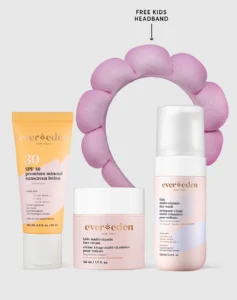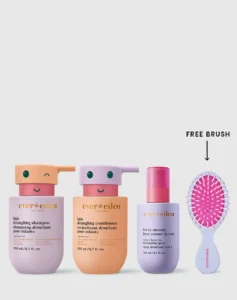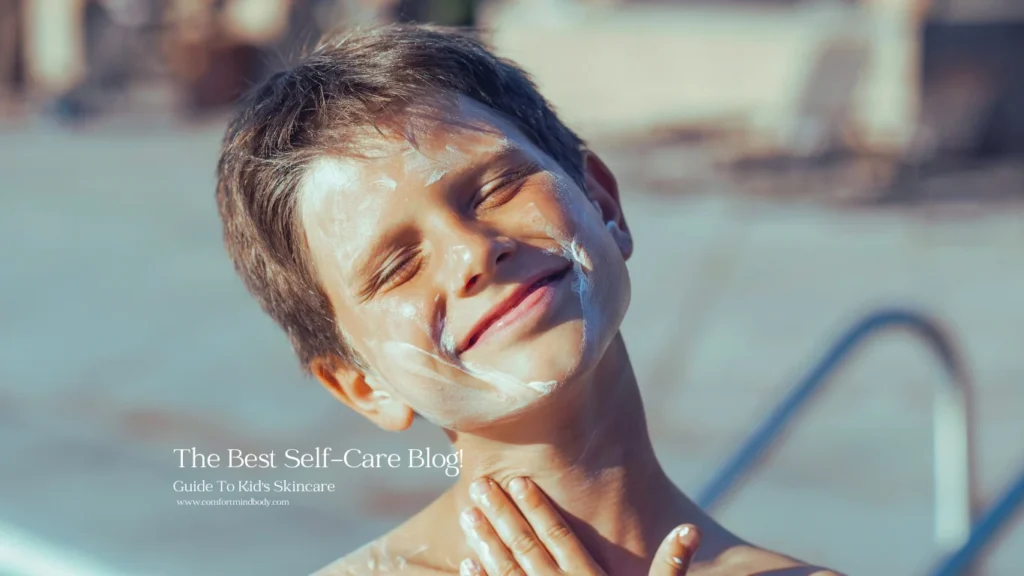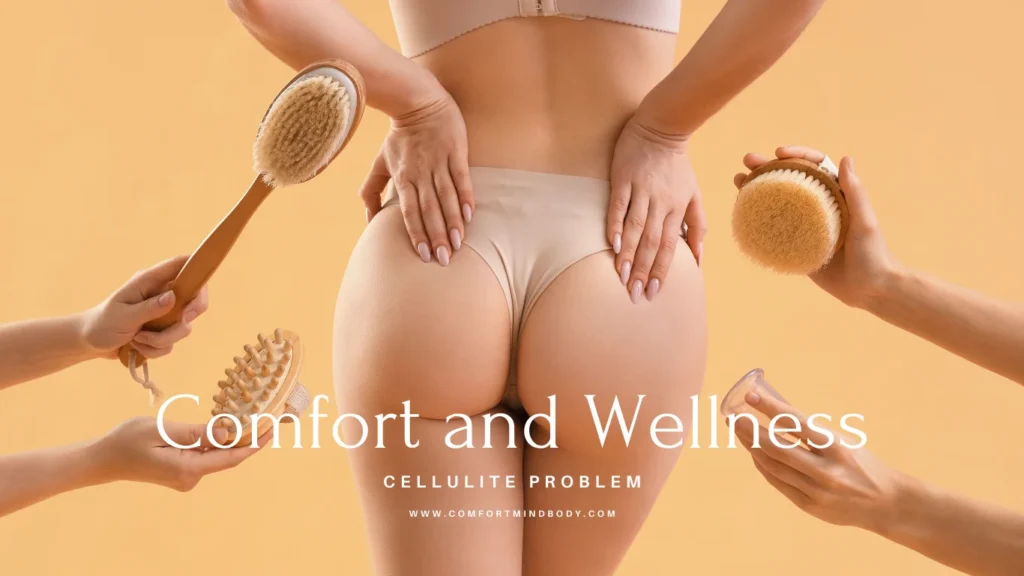Table of Contents
Toggle6 Essential Steps for Kids' Skincare
Skincare is not just for adults. Children, too, need a proper skincare routine. Their skin is delicate and requires special care.
In this article, we will guide you through the essential steps for kids’ skincare. Understanding the unique needs of your child’s skin is crucial.
It helps you protect their skin from common issues like eczema and diaper rash. A balanced diet and proper hydration play a significant role in maintaining healthy skin.
Sunscreen is another essential element in kids’ skincare. Choosing the right skincare products for your child can be a daunting task.
Adult skincare products may not be suitable for children’s skin. We will provide a step-by-step guide to a basic skincare routine for kids.
We will also discuss the importance of patch-testing new products. Reading labels and understanding the ingredients in kids’ skincare products is important.
Plus, we will explore the benefits of natural and organic skincare options for children This guide will help you establish an effective skincare routine for your child.
We aim to make skincare fun and engaging for kids. Join us as we delve into the world of Guide to Kid’s Skincare!
Understanding Kids' Skin: The Basics
Guide to Kid's Skincare
Children’s skin is different from adults. It’s more delicate and sensitive. Understanding this is the first step in kids’ skincare.
The skin is the body’s largest organ. It serves as a protective barrier against environmental factors. For children, this barrier is still developing. This makes their skin more prone to irritation and damage.
Common skin issues in children include eczema and diaper rash. These conditions can cause discomfort and distress. Identifying these issues early is crucial. It allows for timely treatment and prevention.
A balanced diet is key to healthy skin. It provides the necessary nutrients for skin health. Hydration is equally important. It helps maintain the skin’s moisture balance.
Sunscreen is a must in kids’ skincare. It protects their skin from harmful UV rays. Choosing the right skincare products for children is essential. Adult skincare products may be too harsh for their skin. Here are some key points to remember:
- Children’s skin is more delicate and sensitive than adults.
- The skin serves as a protective barrier against environmental factors.
- Common skin issues in children include eczema and diaper rash.
- A balanced diet and proper hydration are key to healthy skin.
- Sunscreen is a must in kids’ skincare.
- Adult skincare products may be too harsh for children’s skin.
Patch-test
Patch testing new products is important. It helps identify any potential reactions. Reading labels and understanding ingredients is also crucial.
Some ingredients may not be suitable for children’s skin. Natural and organic skincare options can be beneficial. They are often gentler and free from harsh chemicals.
Environmental factors can impact children’s skin. These include weather conditions and pollution. Teaching kids about personal hygiene and skincare is essential.
It helps them understand the importance of taking care of their skin. Self-care routines can also have psychological benefits. They can boost a child’s confidence and self-esteem.
Age-appropriate skincare practices should be followed. What works for a teenager may not be suitable for a toddler. Skin sensitivities and allergies should be addressed properly.
Consulting a pediatrician or dermatologist is advisable. They can provide guidance based on your child’s specific needs. Understanding the basics of kids’ skin is the first step.
It sets the foundation for a proper skincare routine. Remember, every child is unique. Their skincare routine should be tailored to their specific needs.
With the right knowledge and approach, you can ensure your child’s skin remains healthy and vibrant.

Kids Daily 1-2-3 Routine
Changing pre-teen skin needs daily extra support. Cleanse, hydrate, and protect their transitioning skin with this trio of pre-teen skincare essentials. Our Kids Multi-Vitamin Face Wash is a gentle cleanser that removes excess dirt, oil, and pore-clogging impurities. Our Kids Multi-Vitamin Face Cream is formulated to hydrate, balance, and soothe skin thanks to a blend of amino acids and omegas. To top it off with all-day protection, our 100% Premium Mineral Sunscreen SPF 30 is the perfect last step in their daily routine. It’s everything they need to keep their skin happy and healthy as they grow.
Step 1: Gentle Cleansing
Guide to Kid's Skincare
Cleansing is the first step in any skincare routine. For kids, it should be gentle yet effective. The goal is to remove dirt and impurities.
This helps keep their skin clean and healthy. But remember, children’s skin is delicate. Harsh cleansers can strip away natural oils. This can lead to dryness and irritation.
So, how do you choose the right cleanser? Look for products specifically designed for kids. These are usually milder and gentler. Avoid products with strong fragrances or dyes. These can cause allergic reactions or irritation.
Also, avoid products with harsh chemicals. These can disrupt the skin’s natural pH balance. Here are some key points to remember:
- Cleansing is the first step in any skincare routine.
- For kids, it should be gentle yet effective.
- The goal is to remove dirt and impurities.
- Harsh cleansers can strip away natural oils.
- Look for products specifically designed for kids.
- Avoid products with strong fragrances, dyes, or harsh chemicals.
How often should you clense?
How often should you cleanse your child’s skin? This depends on their age and activity level. For babies, a gentle wipe-down may be enough.
For older kids, daily cleansing may be necessary. But remember, over-cleansing can be harmful. It can lead to dryness and irritation. So, it’s all about finding the right balance.
Bathing plays a crucial role in kids’ skincare. It’s a time for cleansing and relaxation. But how often should kids bathe?
Again, this depends on their age and activity level. For babies, a bath every other day may be enough. For older kids, daily baths may be necessary. But remember, over-bathing can be harmful. It can strip away natural oils and cause dryness.
So, use warm water instead of hot. And keep bath time short and sweet. Exfoliation is another aspect of cleansing. But it should be done with caution.
Children’s skin is more sensitive to abrasion. So, avoid harsh scrubs or exfoliants. Instead, opt for a soft washcloth or sponge. And remember, exfoliation should not be done daily.
Once or twice a week is enough. Cleansing is not just about the face. It’s about the entire body. So, pay attention to all areas.
Especially those that are often overlooked. Like behind the ears, under the arms, and between the toes. Remember, gentle cleansing is the first step.
It sets the stage for the rest of the skincare routine. With the right approach, you can keep your child’s skin clean and healthy.
And lay the foundation for good skincare habits.
Step 2: Hydration and Moisturizing
Guide to Kid's Skincare
Hydration and moisturizing are key to healthy skin. Especially for kids, whose skin can easily dry out. Hydration refers to the amount of water in the skin.
Moisturizing is about sealing that water in. Both are crucial for maintaining skin health. But how do you keep your child’s skin hydrated and moisturized?
Let’s start with hydration. The best way to hydrate skin is from the inside out. This means ensuring your child drinks enough water. Aim for at least 8 glasses a day.
But remember, the exact amount depends on their age and activity level. Fruits and vegetables can also help hydrate the skin. They are high in water content and packed with vitamins. So, encourage your child to eat a balanced diet.
Now, let’s talk about moisturizing. After cleansing, apply a gentle moisturizer. This helps seal in the moisture and keep the skin soft. Look for products specifically designed for kids.
These are usually milder and gentler. Avoid products with strong fragrances or dyes. These can cause allergic reactions or irritation. Also, avoid products with harsh chemicals.
These can disrupt the skin’s natural pH balance. Here are some key points to remember:
- Hydration and moisturizing are key to healthy skin.
- The best way to hydrate skin is from the inside out.
- Ensure your child drinks enough water and eats a balanced diet.
- After cleansing, apply a gentle moisturizer.
- Look for products specifically designed for kids.
- Avoid products with strong fragrances, dyes, or harsh chemicals.
How often should you moisturize your child's skin?
This depends on their skin type and the climate. For dry skin or in dry climates, daily moisturizing may be necessary. For oily skin or in humid climates, less frequent moisturizing may be enough. But remember, over-moisturizing can be harmful.
It can clog pores and lead to breakouts. So, it’s all about finding the right balance. Bathing can also help hydrate and moisturize the skin. But remember to keep bath time short and sweet.
And use warm water instead of hot. After bathing, pat the skin dry gently. Then apply a moisturizer while the skin is still damp. This helps lock in the moisture.
Remember, hydration and moisturizing are crucial. They help maintain skin health and prevent dryness and irritation. With the right approach, you can keep your child’s skin hydrated and moisturized.
And lay the foundation for good skincare habits.
Step 3: Sun Protection
Guide to Kid's Skincare
Sun protection is a vital part of kids’ skincare. Children’s skin is more sensitive to the sun’s rays. Without proper protection, they can easily get sunburned.
This can lead to skin damage and increase the risk of skin cancer. So, how can you protect your child’s skin from the sun? The first step is to limit sun exposure.
Especially between 10 a.m. and 4 p.m., when the sun’s rays are strongest. When outside, seek shade whenever possible. And remember, sun protection is necessary even on cloudy days.
UV rays can penetrate clouds and still cause damage. Next, dress your child in protective clothing. This includes long-sleeved shirts, pants, and wide-brimmed hats.
Look for clothing with a high Ultraviolet Protection Factor (UPF). UPF indicates how much UV radiation a fabric allows to reach the skin. The higher the UPF, the better the protection.
Sunglasses can also help protect your child’s eyes from UV rays. Look for sunglasses that block 100% of UVA and UVB rays. Now, let’s talk about sunscreen.
Sunscreen is a must for any sun exposure. Choose a sunscreen with a Sun Protection Factor (SPF) of at least 30. And make sure it offers broad-spectrum protection.
This means it protects against both UVA and UVB rays. Apply sunscreen generously and evenly to all exposed skin. Don’t forget areas like the ears, back of the neck, and tops of feet.
Reapply every two hours, or after swimming or sweating. Remember, no sunscreen can block 100% of UV rays. So, use it in combination with other sun protection measures.
Importance Of SPF
Here are some key points to remember:
- Limit sun exposure, especially between 10 a.m. and 4 p.m.
- Dress your child in protective clothing and sunglasses.
- Use sunscreen with an SPF of at least 30 and broad-spectrum protection.
- Apply sunscreen generously and evenly, and reapply every two hours.
- Use sunscreen in combination with other sun protection measures.
Sun protection is not just for the summer. It’s important all year round. Even in winter, the sun’s rays can reflect off snow and cause sunburn.
And remember, sun protection is not just about preventing sunburn. It’s about protecting your child’s skin health in the long term.
With the right sun protection measures, you can help your child enjoy the sun safely. And instill in them the importance of sun protection from a young age.
This is a crucial step in their skincare routine. And a habit that will serve them well throughout their lives.
Step 4: Addressing Common Skin Concerns
Guide to Kid's Skincare
Children’s skin can be prone to various issues. These can range from diaper rash in infants to acne in pre-teens. Understanding these common skin concerns can help you address them effectively.
Let’s start with diaper rash. This is a common issue in infants and toddlers. It’s usually caused by prolonged contact with wet diapers. To prevent diaper rash, change your child’s diaper frequently.
Apply a barrier cream or ointment after each diaper change. If the rash persists, consult your pediatrician. Next, let’s talk about eczema. Eczema is a chronic skin condition that causes dry, itchy skin.
It’s common in children and can appear anywhere on the body. To manage eczema, keep your child’s skin moisturized. Avoid triggers like harsh soaps and certain fabrics.
And consult a dermatologist for a proper treatment plan. Another common skin concern is cradle caps. This is a type of seborrheic dermatitis that affects infants.
It causes scaly, yellowish patches on the scalp. The cradle cap usually resolves on its own. But gentle washing and brushing can help remove the scales.
Now, let’s discuss acne. Acne is common in pre-teens and teenagers. It’s caused by hormonal changes that lead to increased oil production. To manage acne, encourage your child to wash their face twice a day.
Avoid picking or squeezing pimples, which can lead to scarring. Consult a dermatologist for severe or persistent acne.
Key Points
Here are some key points to remember:
- Diaper rash: Change diapers frequently and use a barrier cream.
- Eczema: Keep skin moisturized and avoid triggers.
- Cradle cap: Wash and brush gently to remove scales.
- Acne: Wash your face twice a day and avoid picking pimples.
Remember, every child’s skin is different. What works for one child may not work for another. So, it’s important to understand your child’s skin and its unique needs.
And consult a healthcare professional for any persistent or severe skin issues. Addressing these common skin concerns is a crucial part of kids’ skincare.
It can help maintain your child’s skin health and comfort. And it can also help instill good skincare habits from a young age. So, don’t overlook this important step in your child’s skincare routine.
With the right care and attention, you can help your child navigate these common skin concerns. And set them on the path to lifelong skin health.
Step 5: Choosing the Right Products
Guide to Kid's Skincare
Choosing the right skincare products for your child is crucial. The wrong products can cause skin irritation or even allergic reactions So, how do you choose the right products?
First, look for products designed specifically for kids. These products are usually gentler and safer for children’s delicate skin. Avoid products that contain harsh chemicals or fragrances.
These can irritate the skin and cause allergic reactions. Instead, opt for products with natural and organic ingredients. These are usually gentler and less likely to cause skin irritation.
Next, consider your child’s skin type. Is their skin dry, oily, or a combination of both? Choose products that are suitable for their skin type. For dry skin, look for moisturizing products. For oily skin, opt for oil-free or non-comedogenic products.
If your child has sensitive skin, choose hypoallergenic products. These are less likely to cause skin irritation or allergic reactions. Also, consider the product’s pH level.
Children’s skin has a slightly acidic pH level. So, choose products with a similar pH level to maintain the skin’s natural balance. Don’t forget about sun protection. Choose a sunscreen with an SPF of at least 30 for your child.
And make sure it’s broad-spectrum, meaning it protects against both UVA and UVB rays. When it comes to bath products, choose gentle, tear-free formulas. Avoid bubble baths, which can dry out the skin and cause irritation.
Finally, remember to patch-test new products. Apply a small amount on your child’s arm and wait 24 hours.
If there’s no reaction, the product is likely safe to use.
Choosing the right products:
Here are some key points to remember:
- Choose products designed for kids.
- Avoid harsh chemicals and fragrances.
- Opt for natural and organic ingredients.
- Consider your child’s skin type.
- Choose products with a similar pH level to your child’s skin.
- Don’t forget about sun protection.
- Choose gentle, tear-free bath products.
- Always patch-test new products.
Choosing the right products is a crucial step in your child’s skincare routine. It can help maintain their skin health and prevent skin issues. So, take the time to research and choose the right products for your child.
And remember, what works for one child may not work for another. So, don’t be afraid to try different products until you find what works best for your child. With the right products, you can help your child maintain healthy, happy skin.
Step 6: Building a Routine and Educating Your Child
Guide to Kid's Skincare
Building a skincare routine for your child is essential. It helps maintain their skin health and teaches them about personal hygiene. But how do you build a skincare routine for your child?
First, start with the basics. This includes cleansing, moisturizing, and sun protection. As your child grows older, you can add more steps to their routine. For example, you can introduce exfoliation once they reach their pre-teen years.
Next, make the routine fun and engaging. You can do this by turning it into a game or a bonding activity. This can make the routine more enjoyable for your child. And it can encourage them to stick to the routine.
Also, educate your child about the importance of skincare. Explain to them why each step is necessary and how it benefits their skin. Use simple language that they can understand. And answer any questions they may have.
Next, be consistent with the routine. Consistency is key to maintaining skin health. So, make sure your child follows the routine every day. But remember, it’s okay to miss a day or two.
What’s important is that the routine is followed most of the time. Also, adjust the routine as your child grows. Their skin needs will change as they age. So, their skincare routine should change too. For example, they may need acne treatments once they reach their teenage years.
Finally, lead by example. Show your child that you also follow a skincare routine. This can encourage them to do the same.
build a skincare routine for your child
Here are some key points to remember:
- Start with the basics.
- Make the routine fun and engaging.
- Educate your child about the importance of skincare.
- Be consistent with the routine.
- Adjust the routine as your child grows.
- Lead by example.
Building a skincare routine for your child is not just about maintaining their skin health. It’s also about teaching them about personal hygiene and self-care. And it’s about helping them develop good habits that they can carry into adulthood.
So, take the time to build a skincare routine for your child. And remember, it’s not about perfection. It’s about progress and consistency.
With the right routine, you can help your child maintain healthy, happy skin. And you can teach them valuable lessons about self-care and personal hygiene. So, start building that routine today.
And watch as your child reaps the benefits of a good skincare routine.
Conclusion: The Importance of Pediatric Skincare
Guide to Kid's Skincare
Skincare is not just for adults. It’s also crucial for children. Pediatric skincare is about more than just maintaining healthy skin. It’s about teaching children the importance of self-care.
And it’s about helping them develop good habits. These habits can benefit them for the rest of their lives. So, don’t overlook the importance of a skincare routine for your child.
Start with the basics and gradually add more steps as they grow. Remember, the goal is not perfection. It’s about progress and consistency. With the right routine, you can help your child maintain healthy skin.
And you can teach them valuable lessons about self-care. So, start building that routine today. And watch as your child reaps the benefits of a good skincare routine.
Remember, skincare is a journey, not a destination. And it’s a journey that’s best started early. So, don’t wait. Start your child’s skincare journey today.
And help them develop healthy habits that will last a lifetime. Because when it comes to skincare, it’s never too early to start.

Kids Multi-Vitamin Body Wash
Guide to Kid's Skincare
Foaming wash with amino acid and omega-rich MegaVitamin Complex™ gently and effectively cleanses entire body, leaving skin feeling healthy, hydrated and protected with each wash. Formulated for children ages 4+, but can be used by the whole family.

Baby Moisturizing Lotion Fragrance Free
Guide to Kid's Skincare
With colloidal oatmeal and superfood-derived oils to gently nourish skin, while also providing long-lasting hydration.

Kids SPF 50 Premium Mineral Sunscreen
Guide to Kid's Skincare
The perfect kids’ sunscreen finally exists. Two years in the making, this innovative fluid formula combines high SPF 50 protection with our proprietary approach comprised of three breakthroughs in one

Kids Happy Hair Trio
Guide to Kid's Skincare
Introducing your new go-to kid’s haircare trio! This set includes our detangling spray, shampoo, and conditioner, each thoughtfully crafted to make hair care clean, simple, and effective.
Kids Berry Smooth 4-in-1 Detangling Spray uses strawberry extract, plant protein peptides, and argan oil to instantly eliminate tangles and soften hair for easy, pain-free combing.
Kids Detangling Shampoo nourishes and cleanses, leaving hair clean without stripping moisture. Kids Detangling Conditioner locks in hydration, smooths, and softens dry strands.
FAQ's
Guide to Kid's Skincare
When should I start a skincare routine for my child?
It’s never too early to start. You can begin with simple steps like gentle cleansing and moisturizing from infancy.
What products should I use for my child's skin?
Always choose products designed for children’s delicate skin.
Look for gentle, hypoallergenic, and fragrance-free options.
How often should I bathe my child?
This depends on the child’s age and activity level.
However, avoid over-bathing as it can dry out the skin.
Does my child need to use sunscreen?
Absolutely. Sunscreen is essential to protect your child’s skin from harmful UV rays.
What should I do if my child has a skin problem?
Always consult a pediatrician or dermatologist for any skin concerns.
They can provide the best advice and treatment options.
Disclosure: Please note that the links within this product review may generate a small commission. This compensation aids in supporting our research and editorial team. We wish to highlight that our recommendations solely pertain to high-quality products.
Disclaimer: This article serves purely informational purposes and is not intended for the diagnosis, treatment, or cure of any medical condition. Prior to making any changes to your diet or lifestyle or taking supplements, it is imperative to consult a qualified healthcare professional.




